Welcome to the world of Tarot and self-care, where the mystical and the practical come together to nurture your emotional well-being. In this article, we will explore the power of Tarot as a tool for self-discovery and delve into various self-care practices that can help you navigate the ups and downs of life. Whether you are new to Tarot or a seasoned practitioner, this guide will provide valuable insights on how to use Tarot cards to cultivate self-awareness, promote healing, and create a sense of balance in your daily life. So, grab your favorite deck, open your heart, and let’s embark on this journey of self-care and empowerment.
Contents
- What is Self-Care?
- Understanding Tarot
- Tarot for Emotional Well-being
- Self-Care Practices with Tarot
- Choosing the Right Tarot Deck
- Building an Emotional Well-being Toolkit
- Creating Rituals and Intentions
- Seeking Professional Support
- Incorporating Self-Care into Daily Life
- Conclusion
-
Frequently Asked Questions
- 1. What are the origins of Tarot cards?
- 2. Can anyone learn to read Tarot cards?
- 3. How do Tarot cards work for emotional well-being?
- 4. Can Tarot cards predict the future?
- 5. How often should I do a Tarot card reading for self-care?
- 6. Is Tarot reading associated with any specific religion?
- 7. How can journaling with Tarot cards be beneficial for self-care?
- 8. Are there different types of Tarot decks?
- 9. How can affirmations and Tarot cards complement each other?
- 10. Should I seek professional support alongside Tarot for emotional well-being?
- References
What is Self-Care?
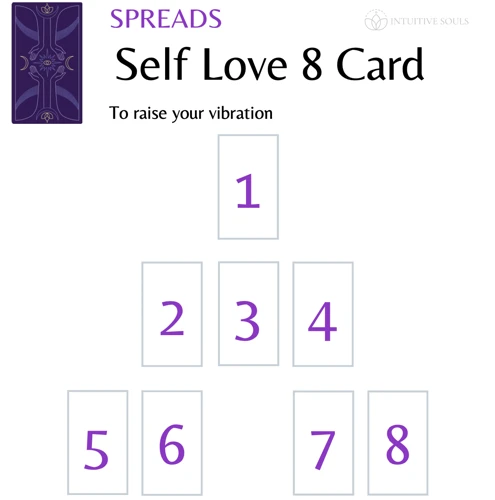
Self-care is a term that has gained significant attention in recent years, but what does it truly mean? At its core, self-care is the practice of taking deliberate actions to prioritize and nurture one’s own well-being, both physically and emotionally. It involves recognizing and honoring your needs, boundaries, and desires – a conscious effort to maintain balance and prevent burnout. Self-care is not selfish; it is a vital aspect of maintaining a healthy and fulfilling life. It can involve a wide range of activities, such as engaging in hobbies, practicing mindfulness, exercising regularly, getting enough sleep, and seeking support when needed. In the context of this article, self-care is about utilizing the powerful tool of Tarot to delve deeper into your own emotional well-being, gaining insights and guidance that can empower you on your journey of self-discovery. Tarot can help you gain a greater understanding of your true self, uncover subconscious patterns and beliefs, and assist in healing past wounds. Through the use of Tarot, you can tap into your intuition, connect with your inner wisdom, and navigate life’s challenges with clarity and confidence. So, let’s dive deeper into the world of self-care and the role Tarot can play in nurturing your emotional well-being. If you’re interested in exploring more about the power of Tarot for self-empowerment, you can also check out our article Harnessing the Power of Tarot for Self-Empowerment or if you’re looking for insights and techniques for self-discovery through Tarot, you can explore Discover Your True Self with Tarot: Insights and Techniques.
Understanding Tarot
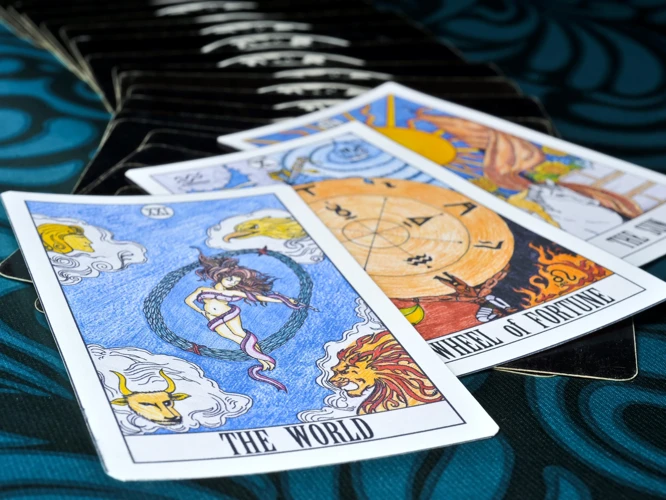
To truly understand Tarot, it is essential to explore its rich history and delve into the meanings behind its mystical cards. Tarot is a deck of 78 cards, each possessing its own unique symbolism and significance. Its origins can be traced back to the 15th century, where it was primarily used as a card game before evolving into a powerful tool for divination and self-discovery. Each Tarot card represents different archetypes, experiences, and energies that mirror the human experience. From the Fool’s journey of new beginnings to the Tower’s transformative upheaval, the Tarot cards hold a mirror to our emotions, thoughts, and experiences. Understanding the meanings behind the cards requires a combination of intuitive interpretation and knowledge of traditional symbolism. The Tarot can serve as a guide, providing insights and illuminating the path of self-discovery. By exploring the depths of the Tarot, we can gain valuable insights into ourselves and gain a greater understanding of our unique journey. If you’re interested in utilizing Tarot for self-discovery, you can find more information in our article on Tarot for Self-Discovery.
1. History of Tarot
The history of Tarot is deeply rooted in mystery and intrigue, with its origins dating back to the 14th century. While the exact origin of Tarot is debated among scholars, it is widely believed to have originated in Europe as a card game. The earliest known Tarot decks were created in Italy, and they consisted of 78 cards divided into four suits – Swords, Cups, Coins (or Pentacles), and Wands (or Staves). These suits were later adapted and became the foundation for the modern playing card deck we are familiar with today.
Over time, Tarot evolved from a simple card game into a tool for divination and spiritual exploration. In the late 18th century, French occultists began to assign symbolic meanings to the cards, linking them to astrology, numerology, and the elements. This transformation marked the birth of Tarot as we know it today – a powerful tool for self-reflection, guidance, and personal growth.
During the 20th century, Tarot experienced a resurgence in popularity with the advent of the New Age movement. Tarot decks started featuring intricate artwork and themes inspired by mythology, astrology, and various spiritual traditions. Today, there is an abundance of Tarot decks to choose from, each with its own unique symbolism and artwork, allowing individuals to connect with the imagery that resonates most deeply with them.
The history of Tarot is rich and diverse, reflecting the evolving beliefs, cultures, and spiritual practices of different eras. While its origins lie in playing cards, Tarot has transcended its humble beginnings to become a valuable tool for self-exploration, guidance, and empowerment. Whether you approach Tarot with skepticism or an open mind, exploring its history can deepen your appreciation for its transformative power.
2. Tarot Card Meanings
Understanding the meanings of Tarot cards is essential for effectively using them as a tool for emotional well-being. Each Tarot card carries its own symbolism and message, offering insights and guidance into different aspects of life. The Tarot deck is composed of 78 cards, divided into two main categories: the Major Arcana and the Minor Arcana. The Major Arcana consists of 22 cards that represent significant life events and archetypal energies. These cards, such as The Fool, The Empress, and The World, hold deep and transformative meanings, reflecting the major themes and lessons in our lives. On the other hand, the Minor Arcana consists of 56 cards divided into four suits: Cups, Wands, Swords, and Pentacles. Each suit represents different elements of human experience, such as emotions, creativity, intellect, and material circumstances. The Ace to Ten cards in each suit signify various aspects of these elements, while the Court Cards (Page, Knight, Queen, and King) represent different personalities or energy types associated with each suit. When interpreting Tarot card meanings, it is important to consider the symbolism, numerology, and intuitive impressions that arise when observing the cards. It is also helpful to consult Tarot guidebooks or online resources that offer interpretations and insights into each card. With practice and experience, you will develop a personal connection with the cards and their meanings, allowing you to tap into their wisdom and guidance for nurturing your emotional well-being.
Tarot for Emotional Well-being
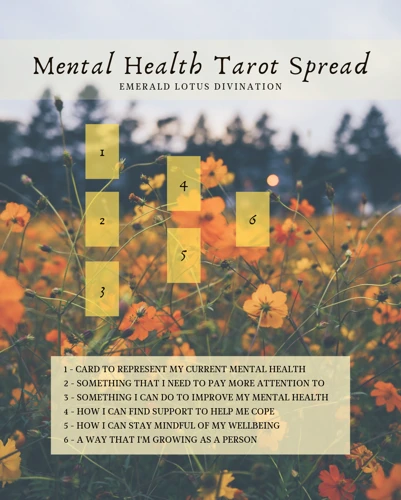
Tarot has long been recognized as a powerful tool for emotional well-being. It offers a unique way to tap into our subconscious mind, bringing clarity and guidance to our emotional experiences. Through the imagery and symbolism of the Tarot cards, we can access deep insights and understanding about our emotions, helping us navigate and process them in a healthy way.
One of the key benefits of Tarot for emotional well-being is its ability to provide validation and affirmation for our feelings. When we draw a card that resonates with our current emotional state, it can offer reassurance that our feelings are valid and normal. This validation can be incredibly comforting and empowering, helping to alleviate any self-doubt or confusion we may be experiencing.
Tarot also serves as a powerful mirror, reflecting back to us the hidden aspects of our emotions. It can bring to light subconscious patterns, beliefs, and fears that may be influencing our emotional well-being. By uncovering these hidden aspects, we gain a deeper understanding of ourselves and can work towards healing and growth.
Tarot can aid in emotional healing. It can guide us towards the root causes of emotional pain, allowing us to address and release past traumas or unresolved emotions. Tarot offers a safe and non-judgmental space to explore our emotions, providing insights and perspectives that may have been previously hidden from us.
In addition to healing, Tarot can assist us in managing and processing complex emotions. It can provide guidance on how to navigate challenging situations, offering different perspectives and options for emotional self-care. The cards can present us with new paths to explore or help us see alternatives to our current emotional state.
Tarot for emotional well-being offers a holistic and intuitive approach to understanding and nurturing our emotions. It helps us gain insight, validation, and guidance to navigate the complexities of our emotional landscape. Whether we seek reassurance, healing, or clarity, Tarot provides a rich and empowering resource for our emotional well-being journey.
Self-Care Practices with Tarot
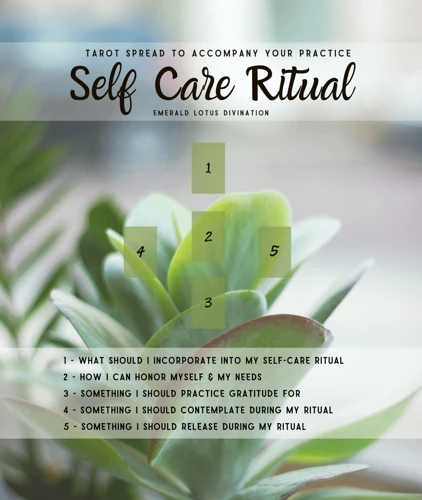
Self-care practices with Tarot are designed to support your emotional well-being and provide you with a sense of groundedness and clarity. The following practices can help you integrate Tarot into your self-care routine:
1. Daily Card Pulls: Start your day by pulling a card from your Tarot deck and reflecting on its message. This simple practice can offer guidance, inspiration, or a gentle reminder for the day ahead.
2. Journaling with Tarot: Use your Tarot cards as a prompt for journaling. Draw a card and write about its imagery, symbolism, and how it relates to your current emotions or experiences. This practice is a powerful way to deepen your self-awareness and gain insight.
3. Meditation with Tarot: Choose a Tarot card that resonates with your current state of mind and use it as a focal point for your meditation practice. Allow the imagery and energy of the card to guide your meditation, bringing a sense of calmness and clarity.
By incorporating these self-care practices with Tarot into your daily routine, you can cultivate a deeper connection with yourself, tap into your intuition, and foster emotional well-being. Remember, as with any self-care practice, it’s important to approach Tarot with an open heart and a willingness to explore and grow through its wisdom.
1. Daily Card Pulls
Daily card pulls are a popular and effective self-care practice that can provide insight, guidance, and inspiration on a daily basis. To incorporate this practice into your routine, start by setting aside a few moments each morning to focus on your intention for the day. Shuffle your Tarot deck while keeping your intention in mind. Once you feel ready, draw a single card from the deck. The card that you pull represents the energies, themes, or messages that may be relevant to your day ahead. Take a moment to study the card’s imagery, symbolism, and keywords. Reflect on how it relates to your intention and what it might be trying to convey to you. Consider journaling about your thoughts and impressions. This simple practice can help you tap into your intuition, gain clarity, and set a positive tone for the day. Remember, there is no right or wrong way to interpret the card. Trust your instincts and allow the wisdom of the Tarot to guide you. Embrace the messages and insights that come through, and be open to any synchronicities or connections that may unfold throughout your day. Engaging in daily card pulls can be a powerful tool for self-reflection, self-discovery, and personal growth. So, grab your Tarot deck, invite the divine guidance, and let the cards illuminate your path.
2. Journaling with Tarot
Journaling with Tarot is a powerful practice that allows you to dive deeper into the meanings and messages conveyed by the cards. It serves as a personal record of your journey, providing insight, clarity, and a means of self-reflection. To begin journaling with Tarot, start by selecting a Tarot card that resonates with you or represents a specific situation or question you have. Take a few moments to really study the imagery and symbolism on the card, allowing it to speak to you intuitively. Then, write down your initial thoughts and impressions. What emotions does the card evoke? What themes or symbols stand out to you? Next, explore the traditional meanings associated with the card. Consider how these interpretations relate to your own life and experiences. As you deepen your understanding of the card, reflect on how it connects to your current situation or emotional well-being. Use your journal as a safe space to explore your thoughts and feelings. Write freely and honestly, allowing your intuition to guide you. You may also use journal prompts to further explore the card’s significance. For example, you can ask yourself: What lessons can I learn from this card? How does it reflect my current challenges or aspirations? How can I apply its wisdom to my life? As you continue to journal with Tarot, you’ll begin to notice patterns, insights, and personal growth. Your journal becomes a treasure trove of wisdom and self-discovery, providing a space for self-care and emotional healing. Take the time to regularly revisit your journal entries, reflecting on your progress and celebrating your achievements. The process of journaling with Tarot can be deeply cathartic and transformative, helping you to gain clarity, release emotional blockages, and nurture your emotional well-being. So, grab your favorite Tarot deck and a journal, and embark on this beautiful journey of self-exploration and self-care.
3. Meditation with Tarot
Meditation is a powerful practice that allows us to quiet the mind, find inner stillness, and connect with our deeper selves. When combined with Tarot, it becomes an even more transformative experience. Meditation with Tarot involves using Tarot cards as focal points for your meditation practice, allowing their imagery and symbolism to guide your journey within. To begin, find a quiet and comfortable space where you won’t be disturbed. Select a Tarot card from your deck that resonates with your current emotions, intentions, or the energy you wish to cultivate. Place the card in front of you and take a few deep breaths to center yourself. Gaze at the card, allowing your eyes to explore its details. Observe the colors, symbols, and figures depicted on the card. As you continue to breathe deeply, let the card’s energy and message sink into your awareness. Close your eyes and visualize yourself entering the scene depicted on the card. Imagine stepping into the card and experiencing it as if you were a part of it. Notice the sensations, feelings, and insights that arise as you immerse yourself in the card’s world. You can also ask specific questions or seek guidance from the card during your meditation. Trust your intuition and listen for any messages or subtle shifts in energy. After a few minutes of immersing yourself in the card’s energy, slowly open your eyes and take a few moments to reflect on your experience. Journaling about your meditation session can help you further explore the insights you gained. By combining meditation and Tarot, you have the opportunity to access deep wisdom, gain clarity, and cultivate a sense of calm and serenity. Regular practice of meditation with Tarot can enhance your self-care routine and support your emotional well-being. Whether done as a standalone practice or in conjunction with other self-care activities, meditation with Tarot can be a transformative and enlightening experience.
Choosing the Right Tarot Deck
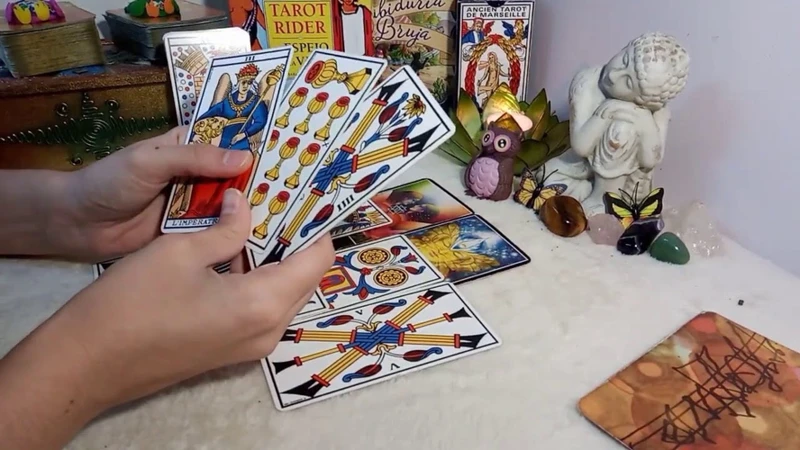
When it comes to Tarot, choosing the right deck is a personal and important decision. There are countless Tarot decks available, each with its own unique artwork, symbolism, and energy. Here are some factors to consider when selecting your ideal Tarot deck:
1. Intuition: Trust your intuition when browsing through Tarot decks. Pay attention to the decks that resonate with you on a deep level. Look for artwork and imagery that speaks to your heart and stirs your imagination.
2. Theme and Symbolism: Consider the theme and symbolism of the deck. Some decks follow traditional Rider-Waite imagery, while others explore different cultural or spiritual traditions. Choose a deck that aligns with your interests, beliefs, or areas of study.
3. Deck Size: Tarot decks come in various sizes, from standard to pocket-sized. Think about how and where you plan to use your deck. A larger deck may be more visually appealing for studying at home, while a smaller deck can be easily carried with you for daily draws on the go.
4. Guidebook Availability: Check if the deck comes with a guidebook or companion app. Guidebooks can provide valuable interpretations and insights into the cards, making it easier for beginners to understand the meanings and symbolism. However, some readers prefer decks without guidebooks to encourage their own intuitive interpretations.
5. Energy Connection: When possible, hold the deck in your hands or view the images online to feel the energetic connection. Notice if the deck evokes any specific emotions or sensations. Trust your gut feelings as you assess the energy of the cards.
As you explore different Tarot decks, remember that there is no right or wrong choice. Each deck has its own personality and can offer unique perspectives and experiences in your Tarot practice. Allow yourself to be drawn to the deck that resonates with you the most, and trust that it will be the perfect tool for your self-care journey with Tarot.
Building an Emotional Well-being Toolkit
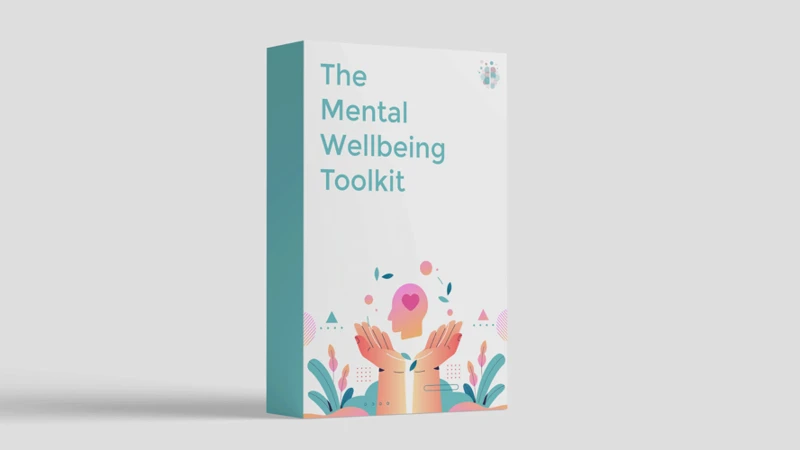
Building an emotional well-being toolkit is an essential aspect of self-care, providing resources and practices that support your emotional health and overall well-being. In addition to Tarot, there are various tools and practices that can be incorporated into your toolkit. One powerful tool is affirmation cards, which consist of positive statements that can help shift your mindset and cultivate self-love and confidence. These cards can be drawn daily, serving as reminders of your worth and potential. Another tool that can be beneficial is crystal healing, where specific crystals are used to support different aspects of emotional well-being. Crystals such as rose quartz for love and compassion, amethyst for calming anxieties, or citrine for abundance and positivity can be used in meditation or carried with you throughout the day. Essential oils are also a valuable addition to an emotional well-being toolkit, as they have the power to evoke emotions and promote relaxation. Scents like lavender for sleep and relaxation, bergamot for stress relief, or uplifting citrus oils like lemon and orange can be diffused or applied topically to enhance emotional balance. By building an emotional well-being toolkit that incorporates these practices and tools, you can create a personalized resource that supports your emotional needs and promotes a sense of inner harmony.
1. Affirmation Cards
Affirmation cards are a powerful tool to incorporate into your self-care routine. These cards typically contain positive statements or affirmations that are designed to uplift and inspire you. They serve as gentle reminders of your worth, strengths, and potential. When used in conjunction with Tarot, affirmation cards can amplify their impact and create a more holistic self-care practice. You can use them in various ways to nurture your emotional well-being. One approach is to pull an affirmation card each day and reflect on its message. Allow the affirmation to sink in and resonate with you throughout the day. Another way to utilize affirmation cards is to create a deck specifically tailored to your needs. Write down affirmations that address areas you want to work on, such as self-love, confidence, or abundance. Use these cards as a daily ritual to reinforce positive beliefs and manifest positive change in your life. Affirmation cards can be made or purchased, depending on your preference. Creating your own deck allows for a more personalized experience, while pre-made decks offer convenience and a wide range of affirmations to choose from. Whichever option you choose, the key is to select affirmations that resonate with you on a deep level and align with your emotional well-being goals. Incorporating affirmation cards into your self-care routine can be a gentle yet powerful way to cultivate self-love, shift negative thought patterns, and nurture your emotional well-being.
2. Crystal Healing
Crystal healing is a popular practice that involves the use of various crystals and gemstones to promote healing, balance, and well-being. Crystals are believed to possess unique energies and vibrations that can interact with our own energy fields, helping to restore harmony and alleviate imbalances. Incorporating crystal healing into your self-care routine can be a powerful way to enhance your emotional well-being. Here are a few steps to get started with crystal healing:
1. Choosing the Right Crystals: There are countless types of crystals available, each with its own properties and associations. It’s important to choose crystals that resonate with your specific emotional needs. For example, rose quartz is often associated with love and compassion, while amethyst is known for its calming and soothing properties. Take the time to research and explore different crystals to find the ones that resonate with you the most.
2. Cleansing and Charging: Crystals have the ability to absorb energy, so it’s essential to cleanse and charge them regularly to ensure their optimal effectiveness. You can cleanse your crystals by placing them under running water, burying them in the earth, or smudging them with sage or palo santo. To charge them, you can leave them in direct sunlight or moonlight for a few hours. Trust your intuition and choose the method that feels right for you.
3. Setting Intentions: Before working with your crystals, it can be helpful to set specific intentions or goals for your healing practice. Take a moment to reflect on what areas of your emotional well-being you would like to focus on and infuse these intentions into your crystals. This can be done through meditation, visualization, or simply speaking your intentions aloud.
4. Using Crystals in Self-Care: There are numerous ways to incorporate crystals into your self-care routine. You can place crystals on your body during meditation or relaxation exercises, create crystal grids, carry them in your pocket or purse, or even incorporate them into your bath or skincare routine. Experiment with different methods and find what works best for you.
Remember, crystal healing is a complementary practice and should not replace professional medical or mental health advice. If you have any concerns about your well-being, it’s always a good idea to consult with a healthcare professional. With the right crystals, intentions, and an open mind, crystal healing can be a beautiful addition to your self-care regimen, supporting your emotional well-being and helping you find balance and harmony in your life.
3. Essential Oils
When it comes to building an emotional well-being toolkit, essential oils can be a wonderful addition. These concentrated plant extracts have been used for centuries for their therapeutic properties and can support self-care practices. Here are some ways you can incorporate essential oils into your self-care routine:
1. Diffusing: Using an essential oil diffuser is a popular way to enjoy the aromatic benefits of essential oils. Simply add a few drops of your favorite oil to the diffuser, and as the oil is dispersed into the air, it can create a calming and uplifting atmosphere. Lavender, chamomile, and frankincense are known for their soothing and relaxing properties, while citrus oils like lemon and orange can promote a sense of freshness and energy.
2. Topical Application: Another way to utilize essential oils is by applying them topically. However, it is important to dilute the essential oils with a carrier oil like almond, coconut, or jojoba oil to prevent skin sensitivity. You can create your own customized blends by combining different oils based on your needs. For example, if you’re feeling stressed, a blend of lavender and bergamot essential oils can help promote relaxation.
3. Bathing: Transform your bath into a luxurious and aromatherapeutic experience by adding a few drops of your favorite essential oils to the water. Eucalyptus oil is invigorating and can provide respiratory support, while ylang-ylang oil can promote a sense of calm and balance. Remember to mix the essential oil with a carrier oil or an emulsifier before adding it to the bathwater to ensure even distribution.
4. DIY Self-Care Products: You can also incorporate essential oils into your own DIY self-care products. From homemade body scrubs to facial mists, the options are endless. Not only can you customize the scents based on your preferences, but you can also tailor the essential oils to address specific emotional needs. For example, if you’re looking to boost confidence and self-esteem, a blend of bergamot and grapefruit essential oils can be used in a body lotion.
When using essential oils, it is important to choose high-quality, pure oils to ensure their effectiveness and safety. Always follow the recommended dilution ratios and guidelines for each essential oil, and if you have any existing medical conditions or concerns, consult with a qualified aromatherapist or healthcare professional. Incorporating essential oils into your self-care routine can add an extra layer of sensory pleasure and holistic support to your emotional well-being journey.
Creating Rituals and Intentions
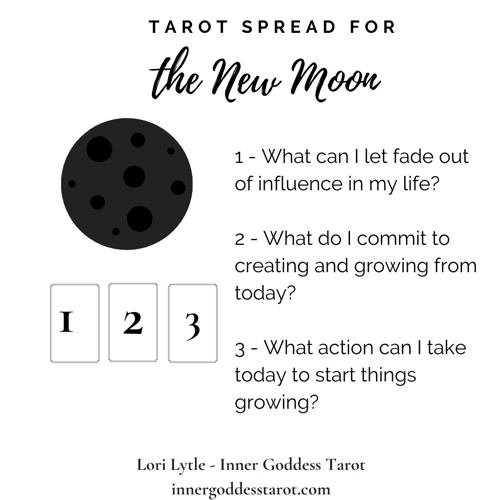
Creating rituals and intentions can be a powerful way to enhance your self-care journey with Tarot. Rituals are intentional practices that can bring a sense of sacredness and meaning to your daily life. They can help create a space for self-reflection, set intentions, and connect with your intuition. One way to incorporate rituals into your Tarot practice is by creating a ritualistic environment. Find a quiet and peaceful space where you can be alone with your Tarot deck. Light candles, burn incense, or play soft music to create a soothing atmosphere. Before beginning your Tarot reading, take a few moments to ground yourself and set your intention for the session. You can do this by closing your eyes, taking deep breaths, and visualizing your intention clearly. It could be gaining insight into a specific issue, seeking guidance, or simply connecting with your inner self. Once you have set your intention, shuffle the cards while focusing on your question or intention. As you draw the cards, pay close attention to your intuition and the messages they convey. Reflect on the symbols, colors, and imagery on the cards, allowing them to guide you in your self-exploration. After your reading, take the time to journal about your insights, emotions, and any actions you feel inspired to take. This helps to solidify your experience and integrate the wisdom gained from the cards. Remember, rituals and intentions are highly personal, so feel free to tailor them to your preferences and needs. By incorporating rituals and intentions into your Tarot practice, you are infusing your self-care journey with a sense of mindfulness, intentionality, and sacredness.
Seeking Professional Support
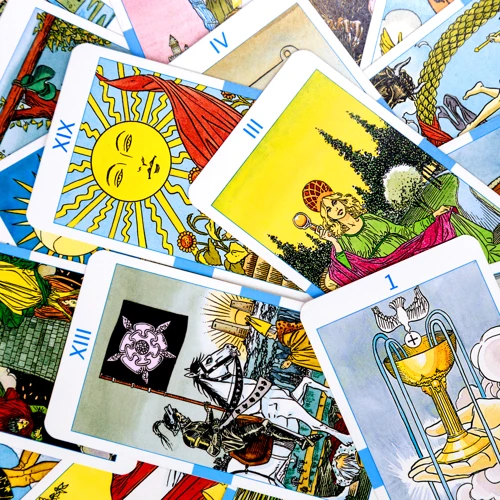
Seeking professional support is an important aspect of nurturing your emotional well-being. When it comes to Tarot, there are two primary sources of professional support that you can turn to. The first is Tarot readers or practitioners who specialize in offering guidance and insights through Tarot readings. These individuals have a deep understanding of Tarot symbolism and can provide you with valuable interpretations of the cards based on your specific questions or areas of focus. Working with a Tarot reader can offer clarity, validation, and a fresh perspective on your life circumstances. The second source of professional support is therapists or counselors who incorporate Tarot into their practice. These professionals have expertise in psychology and mental health and are trained in using Tarot as a therapeutic tool. They can help you explore your emotions, gain insight into underlying issues, and facilitate healing through a combination of traditional therapy techniques and Tarot symbolism. Whether you choose to work with a Tarot reader or a therapist who incorporates Tarot, seeking professional support can provide you with the guidance and support you need to navigate challenges, heal wounds, and cultivate emotional well-being.
1. Tarot Readers
Tarot readers are individuals who have developed a deep understanding of Tarot cards and their interpretations. Engaging with a Tarot reader can be a transformative and enlightening experience on your self-care journey. These skilled practitioners have honed their intuition and expertise to provide guidance and insight into various aspects of your life.
When seeking out a Tarot reader, it’s important to find someone who resonates with you and your needs. Research different readers and their specialties to find someone who aligns with your specific interests or concerns. You can find Tarot readers through online platforms, social media, or local metaphysical shops.
During a Tarot reading, the reader will typically ask you to focus on a specific question or area of your life that you would like guidance on. They will then shuffle the cards and lay them out in a spread, interpreting the cards’ meanings and how they relate to your question or situation. Tarot readers often use their intuition and connection to the cards to provide deep insights and valuable advice.
A Tarot reading can offer you a fresh perspective, affirm your own intuitive feelings, and help you gain clarity on your path. It can also provide validation, comfort, and support during challenging times. Whether you’re seeking guidance on relationships, career choices, or personal growth, a Tarot reading can be a powerful tool for self-reflection and decision-making.
Remember, Tarot readings should be approached with an open mind and a willingness to explore different perspectives. While Tarot readers can offer valuable insights, ultimately, you have the power to make choices and decisions that align with your own intuition and desires.
So, if you’re looking for guidance and a deeper understanding of yourself, consider scheduling a Tarot reading with a trusted and experienced Tarot reader. Their intuitive interpretations can help you uncover hidden truths, gain clarity, and navigate life’s twists and turns.
2. Therapists
When it comes to seeking professional support for your emotional well-being, therapists are an invaluable resource. While Tarot can be a powerful tool for self-reflection and guidance, it is important to remember that it is not a substitute for therapy. Therapists are trained professionals who specialize in helping individuals navigate and overcome a wide range of emotional challenges. They can provide a safe and non-judgmental space for you to explore your thoughts, feelings, and experiences. Whether you are dealing with past traumas, relationship issues, anxiety, depression, or any other mental health concerns, a therapist can offer expert guidance and support. They can help you develop coping strategies, gain self-awareness, and facilitate personal growth. Therapy provides a structured and holistic approach to healing, addressing the underlying emotional, psychological, and behavioral factors that contribute to your well-being. It is important to find a therapist who aligns with your needs and values, someone you feel comfortable opening up to. If you are considering therapy, reach out to professionals in your area or explore online therapy options. Remember, reaching out for professional support is a sign of strength and self-care as it allows you to prioritize your emotional well-being and work towards a healthier and happier life.
Incorporating Self-Care into Daily Life
Incorporating self-care into our daily lives is essential for maintaining overall well-being and balance. It involves consciously prioritizing activities and practices that nurture our physical, mental, and emotional health. One important aspect of incorporating self-care into daily life is setting boundaries. This means learning to say no when necessary, creating space for ourselves, and setting realistic expectations for our time and energy. It also means prioritizing rest and relaxation, recognizing the importance of downtime and rejuvenation. Additionally, nurturing relationships with loved ones is a crucial part of self-care. Spending quality time with those we care about, cultivating meaningful connections, and expressing gratitude can greatly contribute to our emotional well-being. By integrating self-care practices into our daily routines, we can create a foundation of self-nurturing and make our well-being a priority.
1. Setting Boundaries
Setting boundaries is a crucial aspect of self-care and emotional well-being. It involves defining and communicating your limits, needs, and preferences to others, while also respecting their boundaries. By establishing clear boundaries, you create a healthy space for yourself where you can feel safe, respected, and in control of your own experiences. Setting boundaries can be done in various areas of your life, such as personal relationships, work environment, social interactions, and even with yourself. It means recognizing when to say “no” to activities or commitments that don’t align with your values or drain your energy. It also means expressing your needs and expectations in relationships, whether it’s with friends, family, or romantic partners. Setting boundaries requires self-awareness and assertiveness. It means understanding your own limits and advocating for yourself without guilt or fear of judgment. To establish healthy boundaries, reflect on your own values, identify situations and behaviors that make you feel uncomfortable or overwhelmed, and communicate your boundaries assertively and respectfully. Remember, setting boundaries is an ongoing practice, and it may take time to feel comfortable with asserting your needs. However, by prioritizing your emotional well-being and practicing self-care, you empower yourself to create a more balanced and fulfilling life.
2. Prioritizing Rest
Rest is a crucial aspect of self-care that often gets overlooked in our fast-paced and busy lives. Prioritizing rest means intentionally carving out time in your schedule to recharge and rejuvenate your body and mind. It involves recognizing when you need a break and giving yourself permission to rest without guilt. Rest can take many forms, such as getting enough sleep, taking regular breaks during the day, and scheduling downtime for relaxation and leisure activities. When it comes to prioritizing rest, it’s important to listen to your body and honor its needs. This may mean establishing a consistent sleep schedule, creating a relaxing bedtime routine, or incorporating restorative practices such as meditation, deep breathing, or gentle yoga into your daily routine. Remember that rest is not laziness; it is a vital component of self-care that allows you to replenish your energy and restore balance in your life. So, make it a priority to carve out time for rest and relaxation amidst the demands of daily life. Your well-being will thank you for it.
3. Nurturing Relationships
Nurturing relationships is an essential aspect of self-care and maintaining emotional well-being. Our connections with others have a profound impact on our overall happiness and sense of fulfillment. To nurture relationships, it is important to prioritize quality time with loved ones and cultivate open and honest communication. This can involve actively listening to others, expressing gratitude, and showing empathy and understanding. Additionally, setting healthy boundaries is crucial in maintaining harmonious relationships. Boundaries protect your own mental and emotional well-being, allowing you to maintain a sense of self and prevent feelings of resentment or burnout. It is also important to surround yourself with individuals who support and uplift you, and to let go of toxic relationships that drain your energy. Engaging in shared activities, such as going for walks, cooking together, or simply spending quality time, can deepen the bond with loved ones. Remember, nurturing relationships goes beyond just romantic partnerships; it includes friendships, family connections, and even your relationship with yourself. Take time to cultivate and nourish these relationships, as they are vital components of a fulfilling and balanced life.
Conclusion
In conclusion, incorporating self-care practices into your daily life is essential for nurturing your emotional well-being. Tarot can be a powerful tool in this journey, offering insights, guidance, and self-discovery. By regularly engaging in practices such as daily card pulls, journaling, and meditation with Tarot, you can deepen your connection with yourself and gain clarity on your emotions and experiences. Choosing the right Tarot deck that resonates with you is important, as it will enhance your connection and understanding of the cards. Additionally, building an emotional well-being toolkit that includes affirmation cards, crystal healing, and essential oils can further support your self-care practices. Creating rituals and setting intentions can help you cultivate a sense of purpose and grounding. Seeking professional support from Tarot readers or therapists can also provide valuable guidance and insight along your journey. Incorporating self-care into your daily life means setting boundaries, prioritizing rest, and nurturing your relationships. Remember, self-care is not an indulgence, but a necessity for your overall well-being. So, take the time to prioritize your emotional health, listen to your intuition, and embrace the transformative power of Tarot on your path to self-discovery and self-care.
Frequently Asked Questions
1. What are the origins of Tarot cards?
Tarot cards have a rich history that dates back to the 15th century. Originally, they were used as playing cards in Europe, but eventually gained popularity as a tool for divination and self-reflection.
2. Can anyone learn to read Tarot cards?
Yes, anyone can learn to read Tarot cards! It may take time and practice to develop your intuition and understanding of the symbols, but with dedication and an open mind, anyone can tap into the wisdom of the Tarot.
3. How do Tarot cards work for emotional well-being?
Tarot cards can work for emotional well-being by offering insights into our emotions, thought patterns, and behaviors. They act as a mirror, helping us gain clarity, process our emotions, and develop self-awareness, leading to personal growth and healing.
4. Can Tarot cards predict the future?
While Tarot cards can provide guidance and insights, they do not predict the future with certainty. The future is not set in stone, and our actions and choices can influence the outcome. Tarot serves as a tool for self-reflection and empowerment rather than fortune-telling.
5. How often should I do a Tarot card reading for self-care?
There are no strict rules for how often you should do a Tarot card reading for self-care. It depends on your personal preference and needs. Some people find daily or weekly readings helpful, while others prefer monthly or occasional sessions. Trust your intuition and do what feels right for you.
6. Is Tarot reading associated with any specific religion?
No, Tarot reading is not associated with any specific religion. It is a tool that can be used by individuals of various spiritual beliefs or those who do not follow a specific religion. Tarot is more focused on personal reflection and empowerment.
7. How can journaling with Tarot cards be beneficial for self-care?
Journaling with Tarot cards can be beneficial for self-care as it allows you to explore your thoughts, feelings, and insights that arise during a reading. It helps deepen your understanding, promotes self-reflection, and serves as a record of your progress and growth.
8. Are there different types of Tarot decks?
Yes, there are numerous types of Tarot decks available, each with its own unique artwork, symbolism, and energy. Some popular decks include the Rider-Waite Tarot, the Thoth Tarot, and the Marseille Tarot. Choose a deck that resonates with you and sparks your intuition.
9. How can affirmations and Tarot cards complement each other?
Affirmations and Tarot cards can complement each other by reinforcing positive beliefs and intentions. You can incorporate affirmations inspired by your Tarot readings or use Tarot cards to find guidance in creating affirmations that align with your goals and aspirations.
10. Should I seek professional support alongside Tarot for emotional well-being?
While Tarot can be a valuable tool for self-reflection, it is important to remember that it is not a substitute for professional support. If you are dealing with significant emotional challenges or mental health issues, it is advisable to seek guidance from a licensed therapist or counselor who can provide you with the necessary support and guidance.






